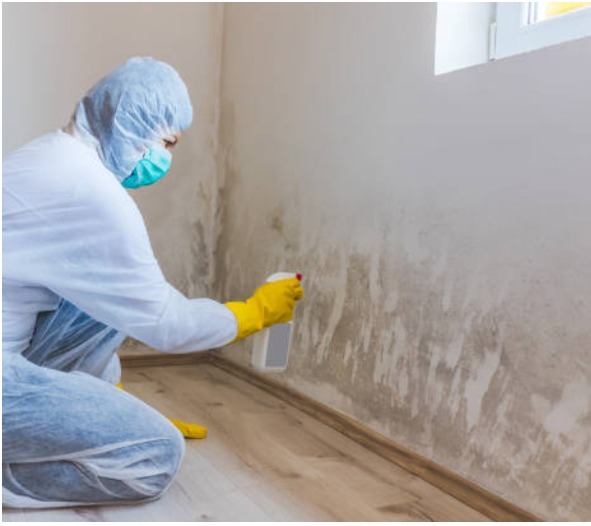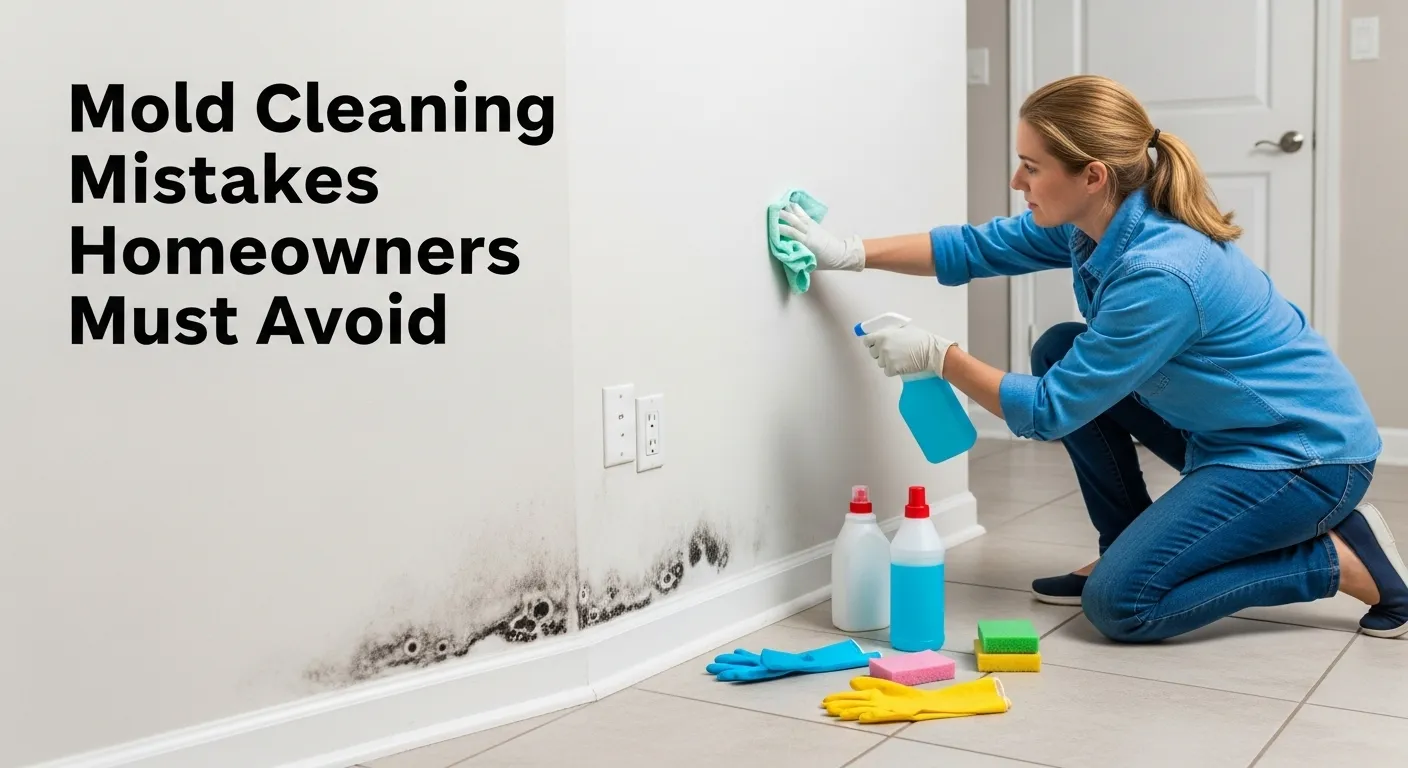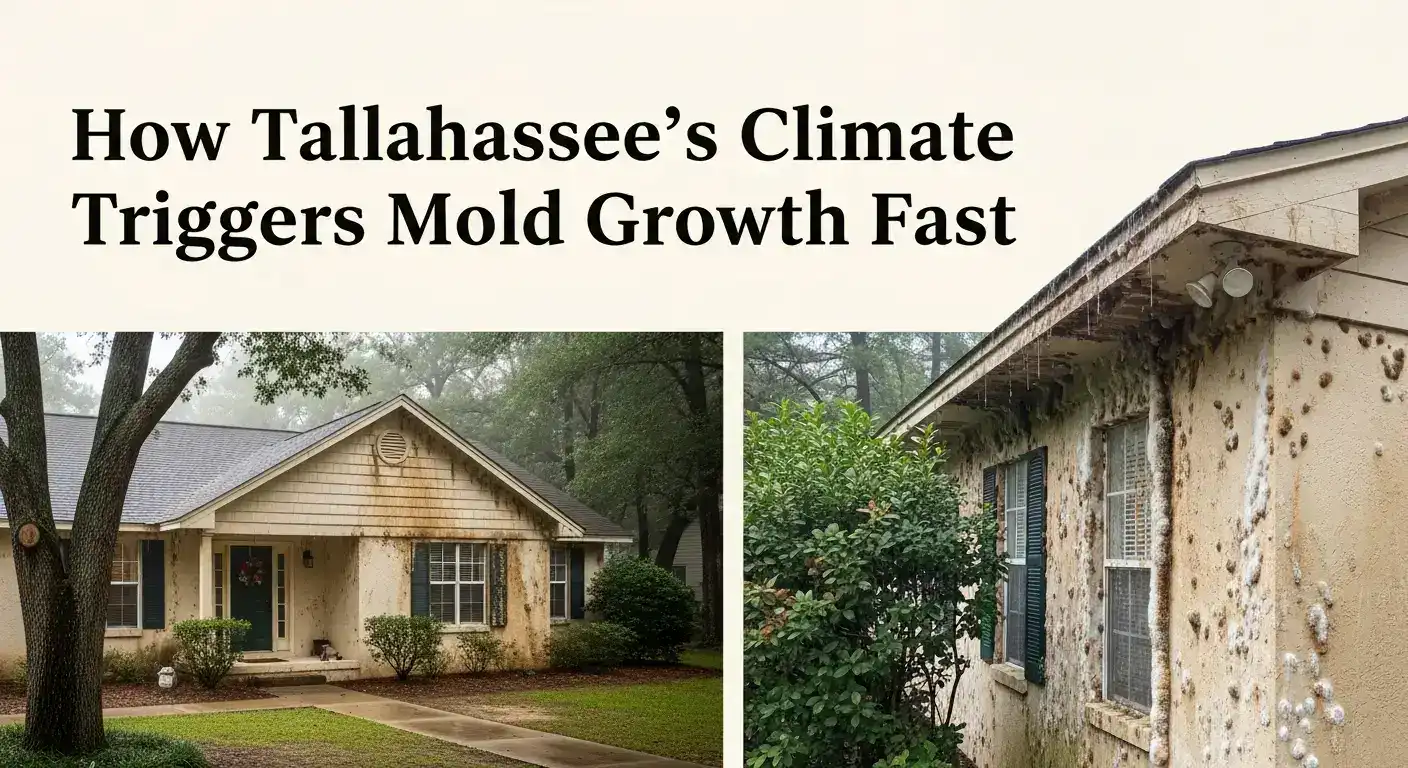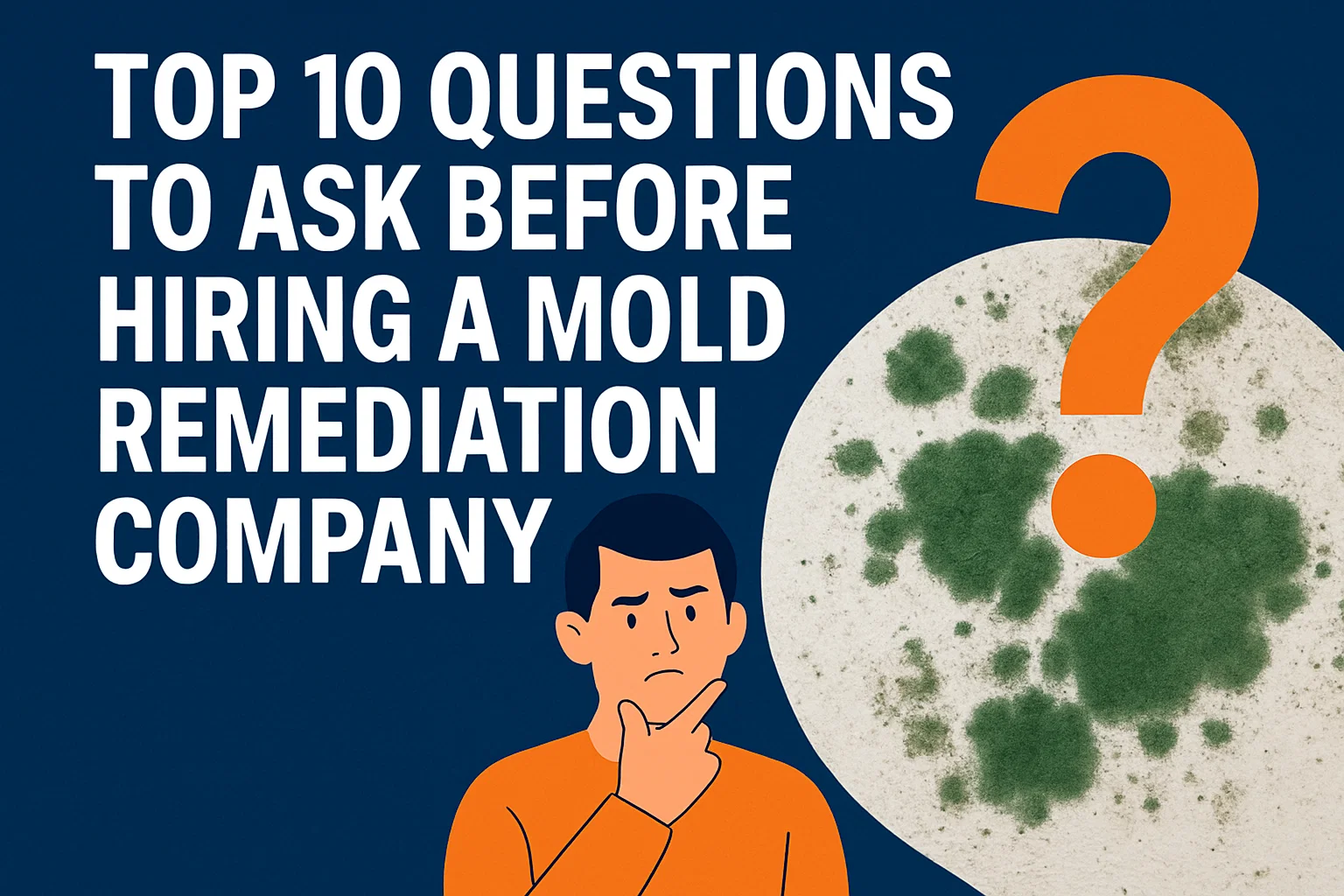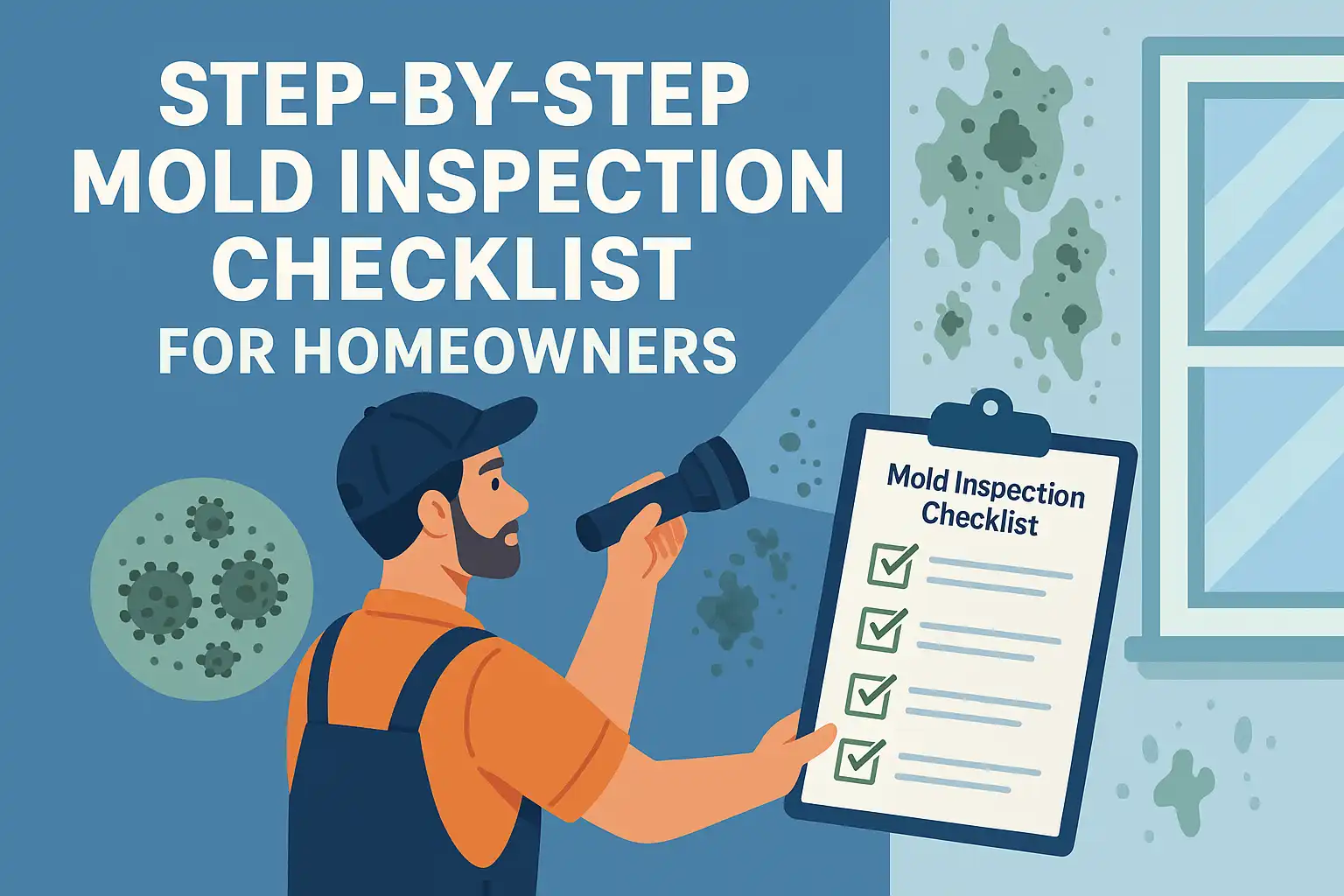Black Mold in Tallahassee, FL: Health Risks, Testing, Prevention Tips, and Safe Removal Guide
Black mold also known as stachybotrys chartarum can release spores and, in some cases, mycotoxins into the air. In North Florida’s warm and humid climate, Black Mold finds plenty of opportunities to grow. It usually grows on drywall, wood, and other cellulose-rich materials after flooding, hurricanes, or hidden leaks.
These particles may cause many health issues including asthma, allergic reactions, and create unsafe living or working conditions. In this guide we will understand what black mold is and how it differs from other molds. We will also talk about the signs of black mold, when and how to test it and what are the safe removal tips. Let’s get started.

What is Black Mold (Stachybotrys chartarum) and How It Differs from Mildew and Other Molds?
Black mold is the common name for Stachybotrys chartarum, a type of fungus that thrives in damp, moisture rich conditions. It often appears as dark greenish-black patches on drywall, wood, or paper-based materials that have stayed wet for days or weeks.
What sets black mold apart from other molds isn’t just the color. It’s the way it grows and the conditions it needs. While many molds can start growing within 24–48 hours of a leak or water damage, Stachybotrys takes longer to appear. It prefers constantly wet surfaces with a good amount of cellulose
When it grows, it produces spores and can sometimes release mycotoxins and chemical compounds that may cause irritation or health problems, especially for people with asthma, allergies, or compromised immune systems.
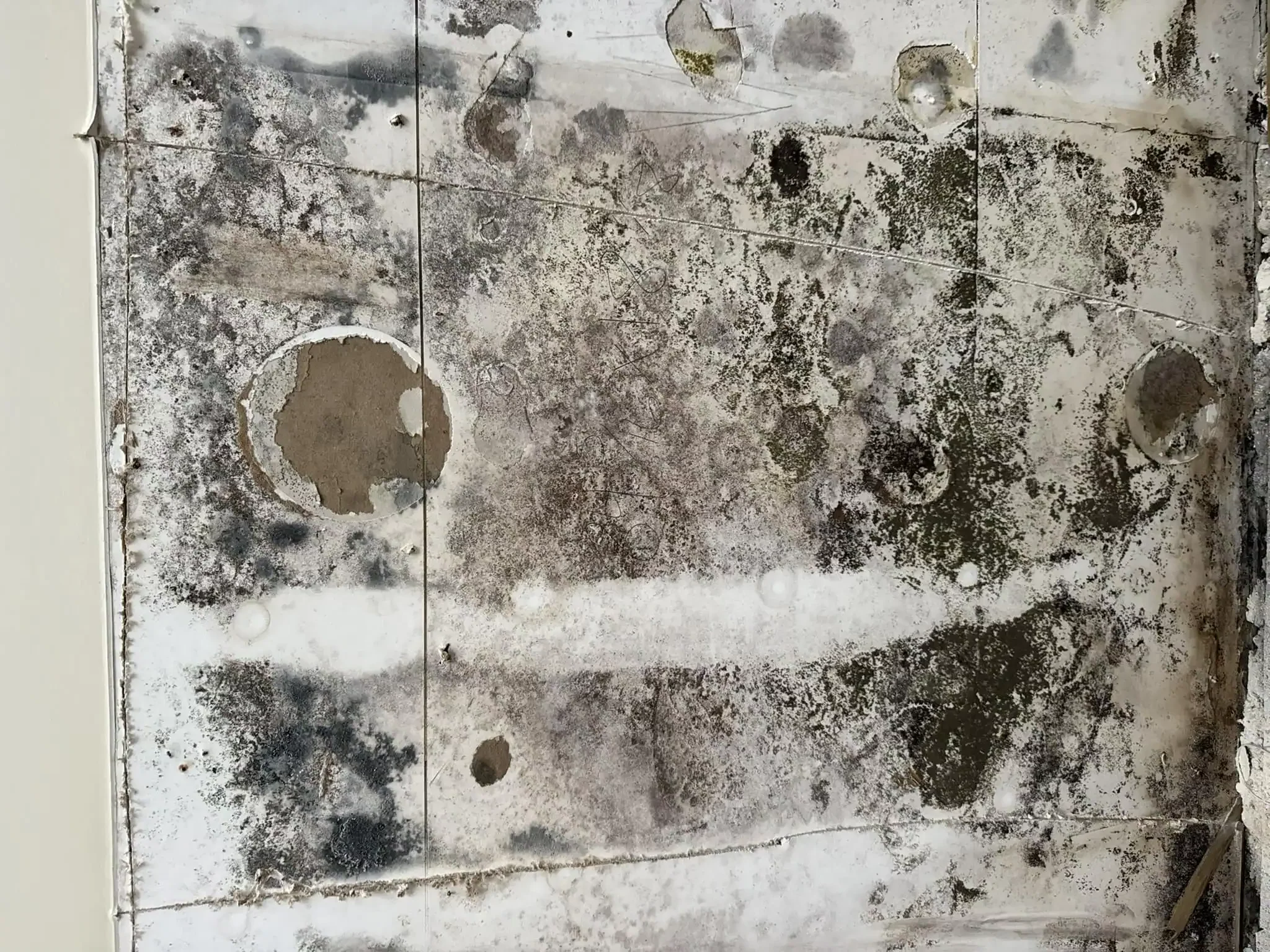
Not every dark patch is black mold, but if you suspect it, you should take it seriously — especially in Tallahassee’s high-humidity environment, where mold spreads faster than in drier climates.
Mildew: On the other hand, Mildew is usually a surface-level issue. It tends to be light gray or white, powdery, and easier to scrub off. Black mold digs deeper into porous materials, making it harder to remove without proper remediation.
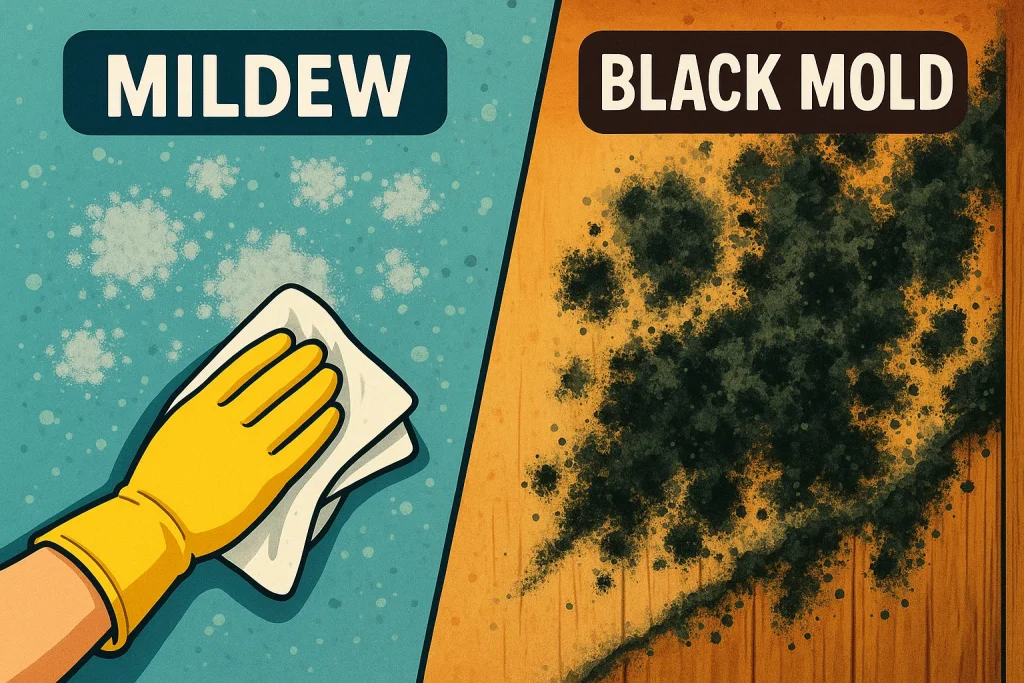
Why Black Mold Grows in Tallahassee Homes and Businesses
Black mold needs three things to grow: moisture, warmth, and a food source like drywall or wood. Tallahassee offers all three almost year-round. Between humid summers, frequent rainstorms, and the occasional hurricane, buildings here face constant moisture challenges.
Even a small leak or condensation problem can create the right conditions for Stachybotrys chartarum to take hold. Once it starts growing, the spores can spread through your air, clothes, pets, or even your HVAC system.
Does the Color of Black Mold Indicate Toxicity or Danger?
A common myth is that if mold is black, it must be highly toxic. In reality, color alone doesn’t tell you how dangerous a mold is. Some molds that look black are relatively mild allergens, while others, like Stachybotrys chartarum, can produce mycotoxins under certain conditions.
The CDC points out that all molds regardless of color have the potential to cause health problems, especially if you have asthma, allergies, or a weakened immune system. The real risk comes from the type of mold, the amount of growth, and how long you’ve been exposed to it.
Tallahassee Climate and Black Mold Growth
Tallahassee’s average annual humidity levels hover around 75%, which is well above the range most experts recommend for mold prevention. Combine that with summer temperatures often in the 80s and 90s, and you’ve got a perfect mold incubator.
Frequent afternoon storms and the wet hurricane season bring even more moisture. When that water finds its way inside through a roof leak, foundation crack, or window seal it can feed a mold colony almost instantly.
Post-Storm Black Mold After Hurricanes and Tropical Systems in North Florida
After a hurricane or tropical storm, black mold becomes a major concern in Tallahassee. Floodwater or wind-driven rain can soak drywall, insulation, and flooring. If those materials aren’t dried quickly, mold spores already in the air will find a home.
According to the EPA, porous building materials that stay wet for more than 48 hours often can’t be saved. In severe cases, removal and replacement are the only safe options. That’s why professional restoration and remediation teams are in such high demand after storms.
Building Factors That Fuel Black Mold
Some Tallahassee homes and businesses are more vulnerable because of the following reasons.
If your building has any of these risk factors, regular inspection and preventive maintenance are critical to avoiding costly remediation later.
Signs of Black Mold in a House
Black mold doesn’t always announce itself right away. Sometimes it hides behind walls or under flooring, quietly spreading while your home’s humidity and moisture levels do the work for it. The sooner you can spot the signs, the easier it is to stop the problem before it damages your home — or your health.
Black Mold on Drywall, Ceilings, and Baseboards After Water Damage
One of the most common places to find black mold is on drywall or ceilings after a leak or flooding. It often starts as small dark spots that grow into larger patches. Baseboards, especially near plumbing or exterior walls, can also show discoloration or warping when moisture has been present for too long.
If you see bubbling paint, peeling wallpaper, or stains spreading across drywall, it could be a sign of an active fungus colony underneath. In Tallahassee’s climate, even a minor roof or plumbing leak can trigger this within days.
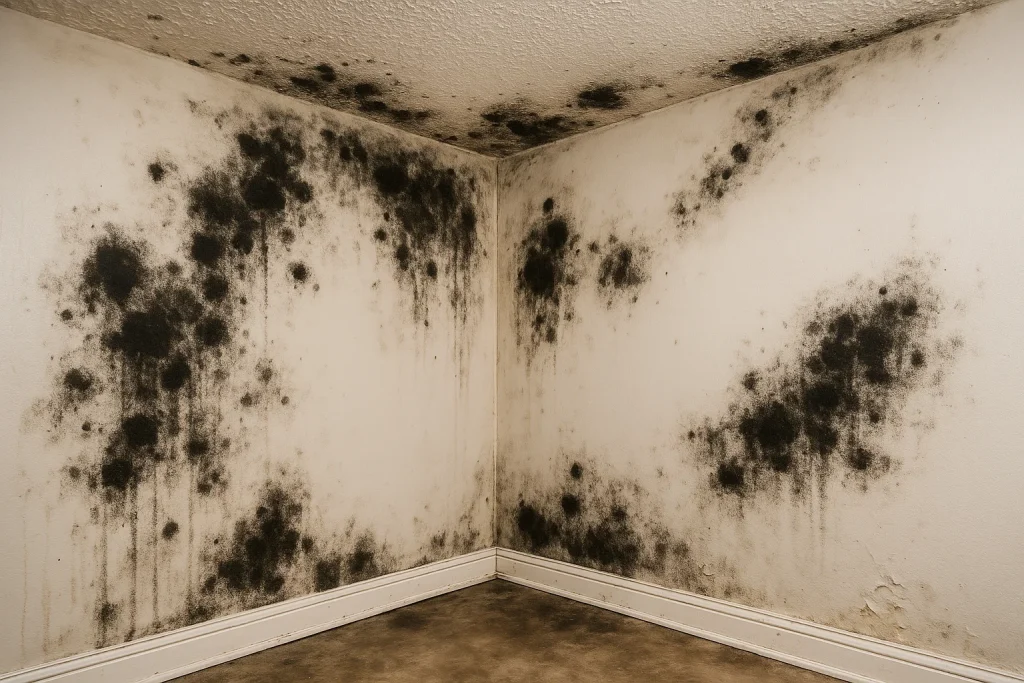
Black Mold Around AC Closets, Supply Plenums, and Return Ducts
Your HVAC system can be a hidden highway for mold spores. The AC closet, supply plenums, and return ducts often have condensation buildup, especially in the summer. If these areas aren’t properly sealed, insulated, and serviced, mold can spread through the ductwork and into every room.
Look for dark spots around vents, musty odors when the system is running, or visible mold growth inside duct panels. Routine inspection and HEPA filtration can help prevent this.
Hidden Black Mold Behind Cabinets, Wallpaper, and Vinyl Flooring
Some of the worst black mold problems are the ones you can’t see. Moisture can get trapped behind kitchen and bathroom cabinets, under vinyl flooring, or between wallpaper and drywall. Because these areas have little airflow, they create the perfect environment for Stachybotrys chartarum to grow.
In cases like this, professional inspection sometimes with moisture mapping or ERMI sampling — is the only way to confirm if mold is present without tearing out materials unnecessarily.
Black Mold Exposure Symptoms
Black mold affects everyone differently, but no one is completely immune to its impact. Breathing in or touching Stachybotrys chartarum may cause mild irritation in some people and more serious symptoms in others, depending on allergies, asthma, or immune system strength.
Black Mold Health Effects In Adults
Exposure to black mold can lead to several health issues in adults. Common symptoms include a stuffy or runny nose, persistent cough, and itchy or watery eyes. It can also cause throat irritation or scratchiness, and worsen asthma symptoms. Additionally, fatigue and headaches are often reported as a result of prolonged exposure.
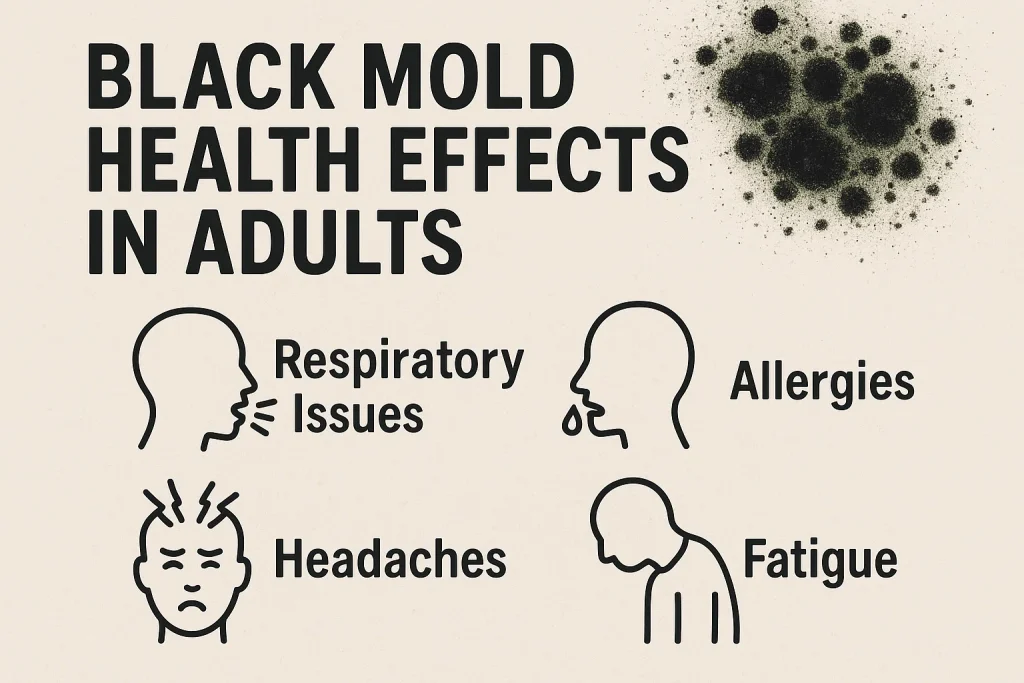
Black Mold Health Effects In Children
In children also back mold can cause various health issues, including frequent allergy symptoms, wheezing, and difficulty breathing. It may also lead to skin rashes or irritation. For children with asthma, exposure increases the risk of more frequent and severe asthma attacks.
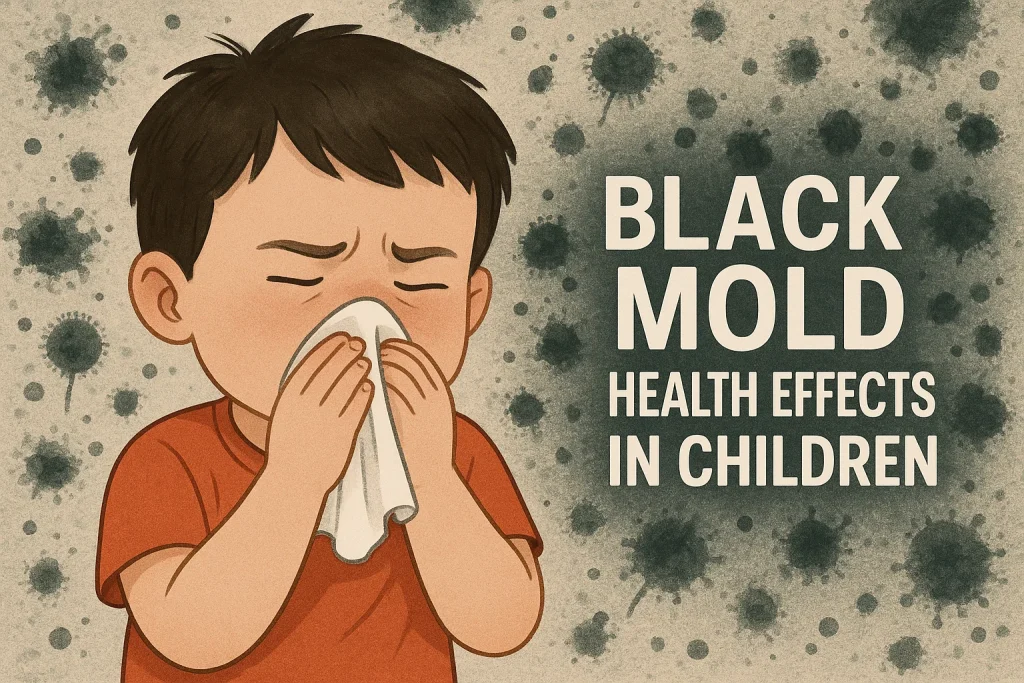
Black Mold Health Effects In Pets
Black mold can have a range of negative health effects on pets too. In pets it can cause sneezing, coughing, or nasal discharge, along with excessive scratching or skin redness. It may also lead to lethargy, loss of appetite, and in severe cases, breathing difficulties. Immediate veterinary care is advised if these symptoms appear.
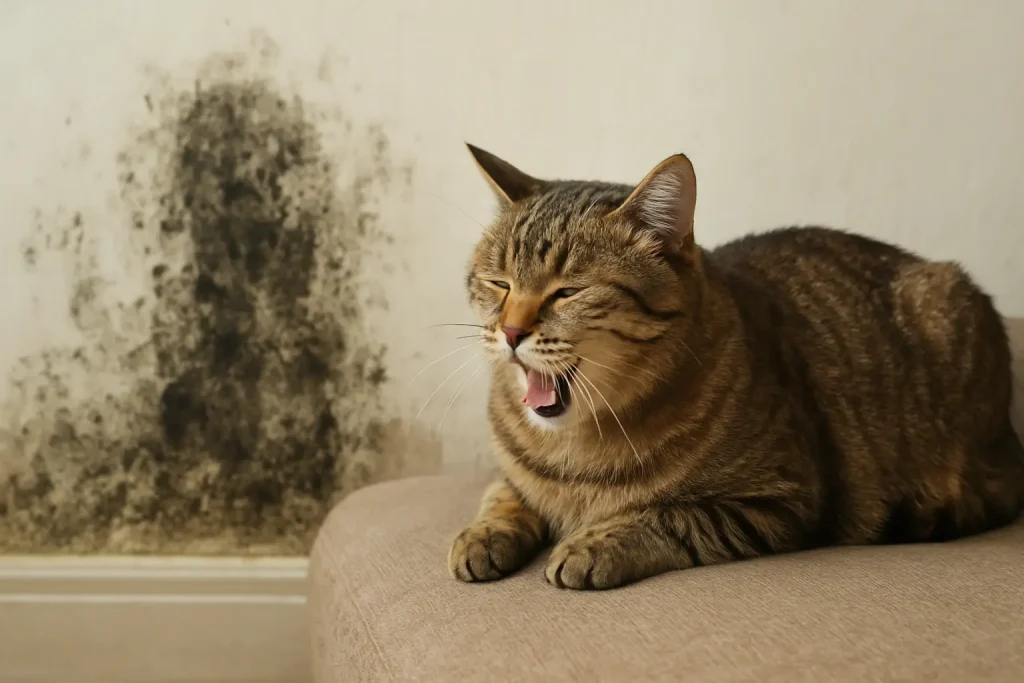
Who Is Most at Risk from Black Mold Exposure
While black mold can irritate anyone, some people are far more vulnerable to its effects. Those most at risk include:
When to See a Doctor About Black Mold Exposure Symptoms
Not every sneeze or cough means you’ve been affected by black mold. But if symptoms persist especially when you’re at home or work in a building with known moisture issues and improve when you are away it’s time to get medical advice.
You should see a doctor if you notice:
If mold is found in your home, medical treatment should go hand in hand with remediation. Addressing symptoms without removing the source of exposure means the problem and your health issues will likely return.
How Quickly Black Mold Can Make You Sick and What Happens if You Breathe It In
How fast black mold affects you depends on your health, sensitivity level, and the amount of exposure. Some people notice symptoms within hours, while others may not feel any effects for days or even weeks.
When you breathe in mold spores, they enter your nose, throat, and lungs. If you’re allergic or sensitive, your immune system reacts almost immediately releasing chemicals like histamine that cause sneezing, coughing, and congestion. Prolonged exposure can inflame the airways, making it harder to breathe.
Short-Term vs. Long-Term Black Mold Exposure Effects
Check out this comparison below.
Short-Term Exposure | Long-Term Exposure |
Sneezing and runny nose | Persistent sinus infections or bronchitis |
Itchy, watery eyes | Worsening asthma or other respiratory conditions |
Scratchy throat or mild cough | Chronic skin irritation |
Headaches or fatigue | Increased allergy sensitivity |
Musty odor sensitivity | Potential long-term inflammation in the lungs |
Causes of Black Mold in Tallahassee Homes
Black mold doesn’t grow without a reason. In almost every case, the root cause is moisture that sticks around too long. Once Stachybotrys chartarum finds a damp surface rich in cellulose, it starts growing. As it develops, it releases spores that can travel through the air or your HVAC system, spreading the problem to other rooms.
Roof and Plumbing Leaks That Lead to Black Mold Growth
A small roof leak during a summer thunderstorm or a slow drip under the kitchen sink can be enough to start a mold colony. In many cases, the damage happens out of sight inside walls, under flooring, or in attic spaces. Over time, that hidden water damage keeps materials damp, giving black mold the steady moisture it needs to thrive.
Condensation and High Indoor Humidity Causing Black Mold on Cold Surfaces
When warm, humid air meets a cold surface like an AC vent, window, or uninsulated wall condensation forms. If it’s not wiped away or the source of humidity isn’t fixed, that moisture can lead to mold growth.
In Tallahassee, indoor humidity can stay above 60% without dehumidifiers or proper ventilation, which makes these cold-surface spots prime targets.
How Black Mold Spreads Through Air Movement and HVAC Systems
Your heating and cooling system can carry mold spores throughout the house. If the ductwork, air handler, or supply plenums have moisture buildup or dust, they can become a breeding ground. Once spores are airborne, they settle on other damp surfaces and start new colonies.
Using HEPA filtration and keeping the HVAC system clean are essential to prevent mold from moving from one room to the next.
How to Test for Black Mold in Tallahassee
Testing is the best way to confirm what you’re dealing with. Testing can also help measure how widespread the problem is.
When Black Mold Testing Is Recommended vs. When It’s Unnecessary
Testing is usually recommended when:
Testing may be unnecessary if:
Air Spore Trap Testing vs. Tape-Lift and Swab Sampling for Black Mold
Each method has strengths and limits, so a professional mold inspector may use more than one to get accurate results.
ERMI and Dust DNA Tests for Black Mold
The Environmental Relative Moldiness Index (ERMI) test uses DNA analysis to identify mold species from dust samples.
Limitations of Black Mold Tests and Why Moisture Mapping Matters Most
Even the best lab test won’t solve a mold problem if the source of moisture isn’t found. That’s why moisture mapping using meters and thermal imaging to track hidden damp spots — is often more important than testing alone.
In Tallahassee’s climate, where moisture can hide for weeks after storms, finding and fixing the source is the only way to stop mold from coming back.
Professional Black Mold Remediation Process
When black mold growth is extensive, hidden inside walls, or contaminating your HVAC system, safe removal requires a certified remediation team. In Tallahassee, reputable contractors follow the IICRC S520 Standard the industry benchmark for mold removal and prevention. Here is the step by step procedure for mold removal.
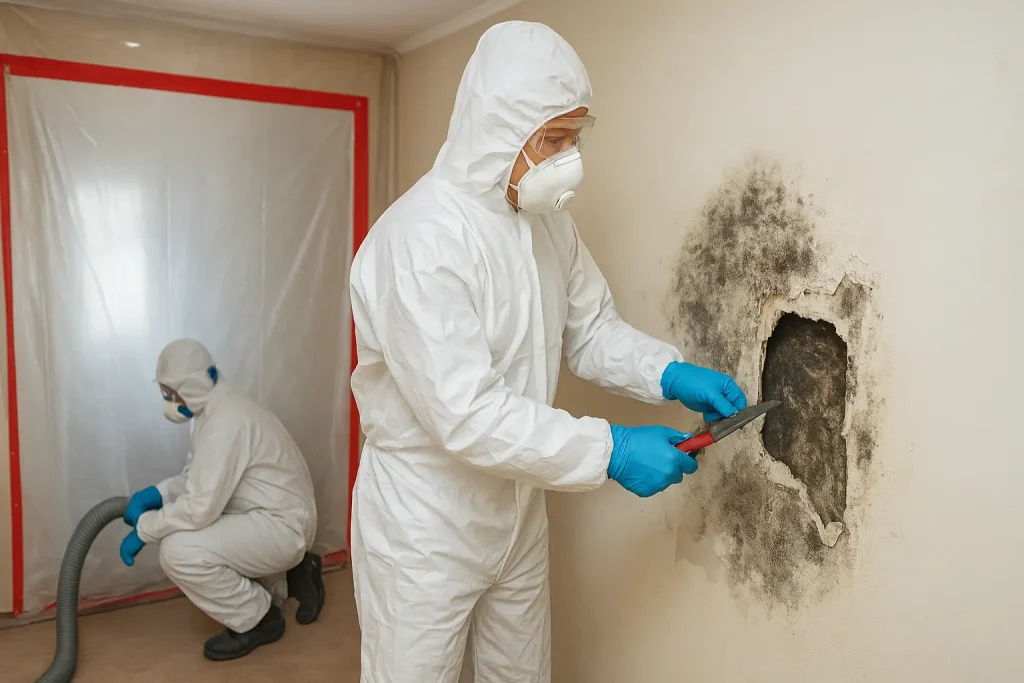
1- Containment and Negative Air Pressure to Control Black Mold Spores
The first step is isolating the affected area. Contractors set up containment barriers with plastic sheeting and use negative air pressure machines equipped with HEPA filtration. This prevents mold spores from escaping into clean areas of the home during removal.
2- Source Removal Cutting Out Moldy Drywall, Insulation, and Carpeting
Professionals physically remove all porous materials contaminated with black mold, such as:
This is the most important step you can’t kill mold trapped deep in porous surfaces; it must be removed.
3- HEPA Vacuuming and Detailed Cleaning of Black Mold-Affected Areas
After demolition, all surfaces are HEPA vacuumed to capture settled spores. Then, crews use antimicrobial cleaning solutions to wipe down and scrub remaining materials, ensuring no active growth remains.
4- Drying to Safe Moisture Levels and Dehumidification Targets
Specialized drying equipment is used to bring building materials down to safe moisture levels. In Tallahassee, this often means maintaining indoor humidity below 50% with dehumidifiers during and after remediation.
5- Post-Remediation Verification (PRV) for Black Mold Clearance Testing
A third-party inspector may perform air sampling or surface tests to confirm the area meets clearance standards. This independent verification ensures the mold has been successfully removed.
6- Rebuild and Restoration After Black Mold Remediation
Once clearance is confirmed, contractors replace removed materials and restore the space to its original condition — without the moisture problems that started the issue.
Black Mold Prevention Tips for Tallahassee’s Humid Climate
Preventing black mold means controlling moisture before it becomes a problem. With average humidity often above 70% and frequent summer storms, homes and businesses need a proactive approach. Here are some practical mold prevention tips you can consider.
Following these steps is far more affordable than paying for full-scale remediation. Pairing regular home maintenance with moisture control is the best long-term defense against Stachybotrys chartarum and other harmful molds.
Cost of Black Mold Remediation in Tallahassee: Price Factors and Timelines
The cost of black mold removal in Tallahassee varies widely. On average, homeowners can expect to pay anywhere from a few hundred dollars for small DIY-safe jobs to several thousand for full-scale professional remediation. The final price depends on the size of the affected area, the materials involved, and whether mold has spread into HVAC systems or hidden structural spaces.
How to Choose a Licensed Black Mold Remediation Company in Tallahassee
Hiring the right contractor can mean the difference between a safe, mold-free home and a recurring problem. Mold remediation is a licensed profession, so homeowners should verify credentials and compare more than just prices.
Credentials to Verify
look for certifications such as the IICRC Applied Microbial Remediation Technician (AMRT) or NADCA HVAC cleaning certification, as these indicate the company adheres to higher industry standards and has undergone specialized training.
Questions to Ask About Black Mold Scope, Containment, and PRV
Before hiring, ask:
Clear, confident answers show they know what they’re doing.
Red Flags
Be cautious of contractors who:
Mold remediation done wrong can leave hidden colonies behind, putting your health and home at risk.
FAQs
H3: How Fast Can Black Mold Affect Your Health?
For sensitive individuals — including children, seniors, and those with asthma — symptoms can appear within hours of exposure. In others, it may take days or weeks of breathing in spores for effects to show.
Is It Safe to Stay in a House With Black Mold During Cleanup?
No. Even if remediation is in progress, airborne spores can spread throughout the home. Staying elsewhere during cleanup protects your health and prevents cross-contamination to your belongings.
What Kills Black Mold on Contact and What Actually Works Long-Term?
Household cleaners may remove surface mold, but only eliminating the moisture source stops regrowth. Long-term success requires physical removal of contaminated materials and thorough drying.
Can I Remove Black Mold Myself or Should I Hire a Professional?
Small, non-porous surfaces can be cleaned safely with the right PPE. Anything larger than 10 square feet, hidden inside walls, or in HVAC systems should be handled by a licensed mold remediator.
Can I Paint Over Black Mold After Using a Stain Blocker?
No. Painting over mold is only a temporary cover-up. Without removing the growth and fixing the moisture source, mold will return and can continue spreading under the paint.

